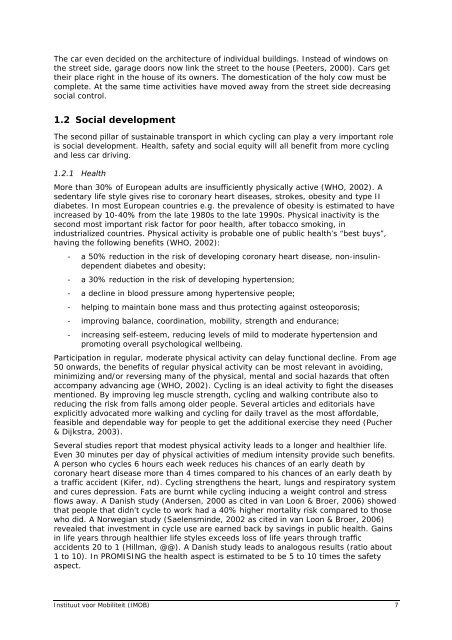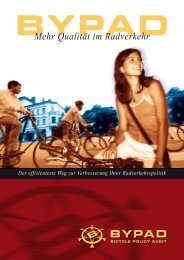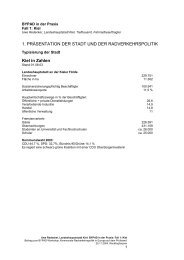Annex I: Literature search bicycle use and influencing ... - ByPAD
Annex I: Literature search bicycle use and influencing ... - ByPAD
Annex I: Literature search bicycle use and influencing ... - ByPAD
You also want an ePaper? Increase the reach of your titles
YUMPU automatically turns print PDFs into web optimized ePapers that Google loves.
The car even decided on the architecture of individual buildings. Instead of windows on<br />
the street side, garage doors now link the street to the ho<strong>use</strong> (Peeters, 2000). Cars get<br />
their place right in the ho<strong>use</strong> of its owners. The domestication of the holy cow must be<br />
complete. At the same time activities have moved away from the street side decreasing<br />
social control.<br />
1.2 Social development<br />
The second pillar of sustainable transport in which cycling can play a very important role<br />
is social development. Health, safety <strong>and</strong> social equity will all benefit from more cycling<br />
<strong>and</strong> less car driving.<br />
1.2.1 Health<br />
More than 30% of European adults are insufficiently physically active (WHO, 2002). A<br />
sedentary life style gives rise to coronary heart diseases, strokes, obesity <strong>and</strong> type II<br />
diabetes. In most European countries e.g. the prevalence of obesity is estimated to have<br />
increased by 10-40% from the late 1980s to the late 1990s. Physical inactivity is the<br />
second most important risk factor for poor health, after tobacco smoking, in<br />
industrialized countries. Physical activity is probable one of public health’s “best buys”,<br />
having the following benefits (WHO, 2002):<br />
- a 50% reduction in the risk of developing coronary heart disease, non-insulindependent<br />
diabetes <strong>and</strong> obesity;<br />
- a 30% reduction in the risk of developing hypertension;<br />
- a decline in blood pressure among hypertensive people;<br />
- helping to maintain bone mass <strong>and</strong> thus protecting against osteoporosis;<br />
- improving balance, coordination, mobility, strength <strong>and</strong> endurance;<br />
- increasing self-esteem, reducing levels of mild to moderate hypertension <strong>and</strong><br />
promoting overall psychological wellbeing.<br />
Participation in regular, moderate physical activity can delay functional decline. From age<br />
50 onwards, the benefits of regular physical activity can be most relevant in avoiding,<br />
minimizing <strong>and</strong>/or reversing many of the physical, mental <strong>and</strong> social hazards that often<br />
accompany advancing age (WHO, 2002). Cycling is an ideal activity to fight the diseases<br />
mentioned. By improving leg muscle strength, cycling <strong>and</strong> walking contribute also to<br />
reducing the risk from falls among older people. Several articles <strong>and</strong> editorials have<br />
explicitly advocated more walking <strong>and</strong> cycling for daily travel as the most affordable,<br />
feasible <strong>and</strong> dependable way for people to get the additional exercise they need (Pucher<br />
& Dijkstra, 2003).<br />
Several studies report that modest physical activity leads to a longer <strong>and</strong> healthier life.<br />
Even 30 minutes per day of physical activities of medium intensity provide such benefits.<br />
A person who cycles 6 hours each week reduces his chances of an early death by<br />
coronary heart disease more than 4 times compared to his chances of an early death by<br />
a traffic accident (Kifer, nd). Cycling strengthens the heart, lungs <strong>and</strong> respiratory system<br />
<strong>and</strong> cures depression. Fats are burnt while cycling inducing a weight control <strong>and</strong> stress<br />
flows away. A Danish study (Andersen, 2000 as cited in van Loon & Broer, 2006) showed<br />
that people that didn’t cycle to work had a 40% higher mortality risk compared to those<br />
who did. A Norwegian study (Saelensminde, 2002 as cited in van Loon & Broer, 2006)<br />
revealed that investment in cycle <strong>use</strong> are earned back by savings in public health. Gains<br />
in life years through healthier life styles exceeds loss of life years through traffic<br />
accidents 20 to 1 (Hillman, @@). A Danish study leads to analogous results (ratio about<br />
1 to 10). In PROMISING the health aspect is estimated to be 5 to 10 times the safety<br />
aspect.<br />
Instituut voor Mobiliteit (IMOB) 7




